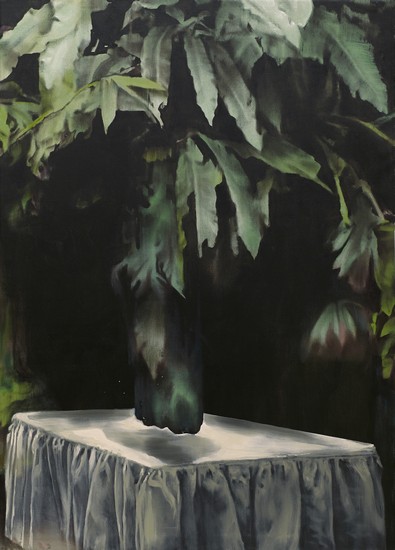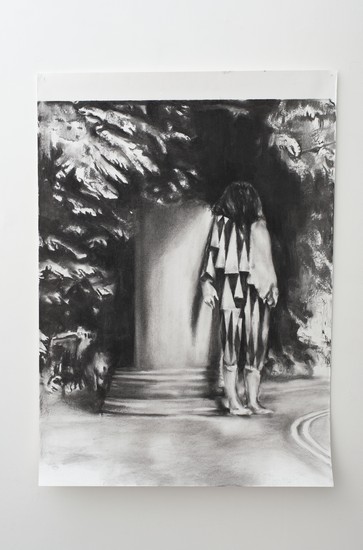Alessandro Scarabello
12.05.2016 – 31.07.2016
Exhibition Views

The Garden of Phersu, 2016, installation view (ground floor), photo by Giorgio Benni 
The Garden of Phersu, 2016, installation view (ground floor), photo by Giorgio Benni 
The Garden of Phersu, 2016, installation view (ground floor), photo by Giorgio Benni 
The Garden of Phersu, 2016, installation view (ground floor), photo by Giorgio Benni 
The Garden of Phersu, 2016, installation view (basement), photo by Giorgio Benni 
The Garden of Phersu, 2016, installation view (basement), photo by Giorgio Benni 
The Garden of Phersu, 2016, installation view (basement), photo by Giorgio Benni 
The Garden of Phersu, 2016, installation view (basement), photo by Giorgio Benni
Works

The Womb, 2015, oil on canvas, cm180x129 
The Gentleman (Prelude), 2016, oil on canvas, cm 194 x 149 
The Minotaur, 2016, oil on canvas, cm 192,5 x 146 
The Pendulum, 2016, oil on canvas, cm 202 x 156 
The Curtain #01, 2016, charcoal on paper, cm 94,5 x 65,5 
The Curtain #02, 2016, charcoal on paper, cm 94,5 x 65,5 
The Curtain #03, 2016, charcoal on paper, cm 94,5 x 65,5 
The Hitch-hiker, 2016, charcoal on paper, cm 105 x 75 
The Gentleman (After Rogier Van Der Weyden), 2016, olio su tela, cm 196 x 132 
The Gentleman #04, 2015, oil on canvas, cm 187 x 152 
Study of a Gentleman, 2016, oil on canvas, cm 92 x 77 
The Gentleman #03, 2015, oil on canvas, cm 170,5 x 133 
The Gentleman #01, 2015, oil on canvas, cm 181 x 137
The Gallery Apart is proud to present The Garden of Phersu, the latest collection of works that Italian artist Alessandro Scarabello produced after gaining an MFA at the Royal Academy of Fine Arts-KASK in Ghent (B) and his relocation in Brussels. An extensive and intensive research that materializes in a series of large and medium-scale paintings and drawings on paper that show not only an artistic evolution but also the continuity with the artist’s previous works, which The Gallery Apart has been following since its very beginning.
The exhibition’s title chosen by Scarabello is a reference that is halfway between history and myth as it recalls the enigmatic figure of Phersu, a character reproduced on the frescoes of Etruscan tombs at Tarquinia (Italy), characterized by physiognomic and proxemic elements that fully render the characteristic of a mask, as also corroborated by the name on the inscriptions – therefore meaning “mask”, corresponding to the Latin “persona”. In the artworks on show, which the artist considers the affirmation of a lexicon consisting of both technical and theoretical elements acquired and absorbed over the last two years, the focus on the body and corporality is mediated through the use of an object-simulacrum, the scarecrow, which imitates the same postures and shapes as those of the human body, but without the limits imposed by reality and verisimilitude, and rather leaving room for deformation and surreality, the mask indeed. In the artist’s imagery, both Phersu (who is the ferryman to the Underworld) and the scarecrow represent figures poised between neurotic laughter and horror, like several other characters from the Commedia dell’Arte and the Italian cultural tradition.
The work by Scarabello has always been related to the drama, the mask, the staging, but today his research is focused on the more specific field of identity. Like in a negative photographic image, the artist tackles it from the point of view of the depersonalisation, in an attempt to clarify how people, in contact with mass culture, with the “show” and the constant proliferation of images, change themselves in order to better adapt to reality so as to effectively pursue strategies, sometimes even instinctive and unconscious, aimed at overcoming the atavistic fear of death. Strategies that sometimes have grotesque connotations, highlighting how men’s reaction to contemporaneity may be awkward, just like their behaviour. In Scarabello’s artworks, the figures’ movements become radicalised due to the lack of verbal communication to then become completely motionless because of an excess of balance.
The image simulacrum created by Scarabello is often set in environments characterized by a dense vegetation. It is a constant element that the artist relates directly with the way Westerners perceive the idea of escape, of distraction, of entertainment. The stereotyped image of landscapes and of nature, and therefore the desire for “exoticism”, for holidays in tropical destinations, comes directly from the (sad) legacy of Western settlers and by their unidirectional perception of the “new world”.
The new collection of works is the result of a long phase of in-depth study and reflection on the alternation of empty and full, dwelling on the experimentation of tridimensionality through the breaking of the canvas and the overlaying of pieces of paintings, influenced by a strong attraction to abstract art which manifested itself with an impulse that pushed him towards the exasperation of gestures and shapes.
All this contributed to the creation of the substratum upon which Scarabello has developed his determination to experiment with colour as well as to tackle the canvas with a greater expressiveness. In the paintings on show the figurative element is given back through an abstract reading of the detail and the notion of “emptiness” materializes itself through the way of painting rather than through the manipulation of the support.
The Gallery Apart è orgogliosa di presentare The Garden of Phersu, l’ultimo ciclo di lavori che Alessandro Scarabello ha realizzato dopo l’MFA alla Royal Academy of Fine Arts-KASK di Ghent (B) e il suo trasferimento a Bruxelles. Un intenso periodo di elaborazione e ricerca che si concretizza in una serie di tele di grandi e medie dimensioni e di disegni su carta che testimoniano tanto l’evoluzione di un percorso quanto la linea di continuità con il lavoro precedente dell’artista che The Gallery Apart segue sin dai suoi esordi.
Scarabello sceglie un riferimento a metà strada tra storia e mito quale titolo della mostra, richiamando la figura enigmatica di Phersu, un personaggio ritratto in affreschi dipinti su alcune tombe etrusche di Tarquinia caratterizzato da elementi fisiognomici e prossemici che ne rendono appieno la caratteristica di maschera, come peraltro confermato dal nome recato dalle iscrizioni che significa appunto maschera e che è poi all’origine del latino persona. Nelle opere proposte in mostra, che l’artista considera l’affermazione di un lessico composto da elementi tecnici e teorici assorbiti e raccolti negli ultimi due anni, l’attenzione al corpo e alla corporeità è mediata attraverso il ricorso ad un oggetto-simulacro, lo spaventapasseri, che del corpo umano ripropone posture e forme, ma senza i limiti imposti dalla realtà e dalla verosimiglianza, bensì lasciando libero spazio alla deformazione e alla surrealtà, alla maschera appunto. Nell’immaginario dell’artista, sia Phersu (che è un traghettatore verso l’Oltretomba) sia lo spaventapasseri rappresentano figure in bilico tra la risata nevrotica e l’orrore, come molte figure della commedia dell’arte e della tradizione culturale italiana.
Il lavoro di Scarabello è da sempre collegato alla teatralità, alla maschera, alla messa in scena, ma oggi la sua ricerca si concentra nell’ambito più specifico dell’identità. Come in una fotografia al negativo, l’artista cura tale ambito sotto il profilo della spersonalizzazione, nel tentativo di chiarire come l’individuo, a contatto con la cultura massificata, lo “spettacolo” e la continua proliferazione di immagini, alteri se stesso per meglio adattarsi alla realtà in modo da perseguire con efficacia strategie, a volte anche istintive e inconsapevoli, tese ad allontanare la paura atavica della morte. Strategie che spesso assumono connotazioni grottesche, evidenziando quanto la reazione dell’individuo alla contemporaneità possa risultare goffa, come lo sono i suoi comportamenti. Nelle opere di Scarabello i movimenti dei soggetti si estremizzano per un deficit di comunicazione verbale e si riducono fino all’immobilità per un eccesso di compensazione.
L’immagine simulacro di volta in volta creata da Scarabello si colloca quasi sempre in ambienti caratterizzati da fitta vegetazione. E’ una costante che l’artista pone in diretta correlazione con il modo in cui gli occidentali percepiscono l’idea della fuga, della distrazione, del divertimento. L’immagine stereotipata dei paesaggi e della natura, e quindi il desiderio di “esotico”, di vacanze in terre tropicali, deriva direttamente dalla (triste) eredità lasciata dai colonizzatori occidentali e dalla loro percezione unidirezionale del “nuovo mondo”.
Il corpo di opere proposto in mostra si perfeziona all’esito di una lunga fase di approfondimento e riflessione, transitata attraverso l’interrogarsi intorno all’alternanza di vuoto e pieno, soffermatasi sulla sperimentazione della tridimensionalità mediante lo sfondamento della tela e la sovrapposizione di brandelli di pittura, influenzata da una forte attrazione per la pittura astratta che si è manifestata in pulsioni verso l’esasperazione di gestualità e forme.
Tutto ciò ha contribuito a creare il sostrato sul quale Scarabello ha acquisito la determinazione ad osare con il colore e ad affrontare con maggiore espressività la tela. Nei dipinti in mostra l’elemento figurativo viene restituito attraverso una lettura astratta del dettaglio e, l’idea di “vuoto” si concretizza attraverso il modo di dipingere anziché la manipolazione del supporto.
share on